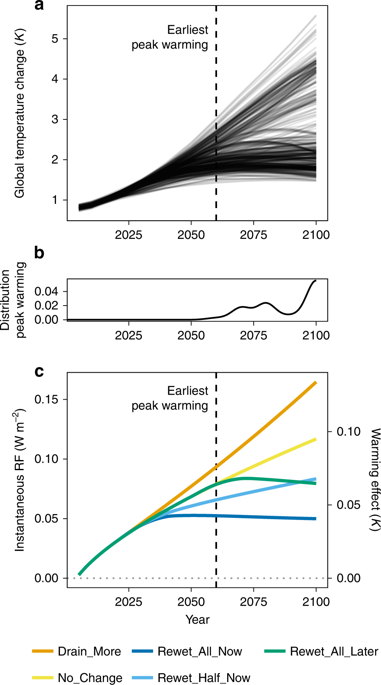Nature Communications ( IF 16.6 ) Pub Date : 2020-04-02 , DOI: 10.1038/s41467-020-15499-z Anke Günther 1 , Alexandra Barthelmes 2, 3 , Vytas Huth 1 , Hans Joosten 2, 3 , Gerald Jurasinski 1 , Franziska Koebsch 1 , John Couwenberg 2, 3

|
Peatlands are strategic areas for climate change mitigation because of their matchless carbon stocks. Drained peatlands release this carbon to the atmosphere as carbon dioxide (CO2). Peatland rewetting effectively stops these CO2 emissions, but also re-establishes the emission of methane (CH4). Essentially, management must choose between CO2 emissions from drained, or CH4 emissions from rewetted, peatland. This choice must consider radiative effects and atmospheric lifetimes of both gases, with CO2 being a weak but persistent, and CH4 a strong but short-lived, greenhouse gas. The resulting climatic effects are, thus, strongly time-dependent. We used a radiative forcing model to compare forcing dynamics of global scenarios for future peatland management using areal data from the Global Peatland Database. Our results show that CH4 radiative forcing does not undermine the climate change mitigation potential of peatland rewetting. Instead, postponing rewetting increases the long-term warming effect through continued CO2 emissions.
中文翻译:

尽管有甲烷排放,但对湿润的泥炭地进行及时的重新湿润可以减少气候变暖。
泥炭地拥有无与伦比的碳储量,是缓解气候变化的战略性地区。排水的泥炭地将这些碳以二氧化碳(CO 2)的形式释放到大气中。泥炭地重新润湿有效地停止了这些CO 2的排放,但也重新建立了甲烷(CH 4)的排放。从本质上讲,管理人员必须在排放的CO 2排放量或重新湿润的泥炭地的CH 4排放量之间进行选择。该选择必须考虑两种气体的辐射效应和大气寿命,其中CO 2是弱而持久的,而CH 4是强烈但寿命短的温室气体。因此,所产生的气候影响与时间密切相关。我们使用了辐射强迫模型,使用来自全球泥炭地数据库的区域数据来比较全球方案未来泥炭地管理的强迫动态。我们的结果表明,CH 4的辐射强迫不会破坏泥炭地再湿润对气候变化的缓解潜力。相反,推迟再润湿会通过持续释放CO 2来增加长期变暖的作用。



























 京公网安备 11010802027423号
京公网安备 11010802027423号